This is an archived article that was published on sltrib.com in 2015, and information in the article may be outdated. It is provided only for personal research purposes and may not be reprinted.
The Sugar House Streetcar — officially called the S-Line — just celebrated its second birthday by achieving a 19 percent increase in ridership so far this year.
But the streetcar is still not reaching even half the ridership that federal officials once predicted it would have.
The Utah Transit Authority announced that the S-Line had more than 363,000 boardings this year through Nov. 30 — about 1,087 per day during that 334-day period.
The federal government expected 3,000 people a day to ride the line when it opened, according to a statement it issued in 2010 to announce a $26 million grant for the project.
The streetcar's busiest day this year was July 4, when the line stayed open late to help transport riders after the Sugar House Park fireworks show. There were 1,700 boardings.
Salt Lake City officials have said early estimates assumed that much of the new development now underway along the line would have been completed when the streetcar opened, but was slowed by the recession. They expect ridership to pick up as apartments and other housing are completed.
"We're pleased to see S-Line ridership has increased by nearly 19 percent over the last year," interim UTA CEO Jerry Benson said in a news release.
"As the communities of Sugar House and South Salt Lake continue to grow," he said, "we expect more riders to adopt this unique form of transportation as a way to explore the neighborhood, access businesses and connect with other UTA services."
The boost in ridership comes after UTA in August extended S-Line service to match the same hours as TRAX — running from about 5 a.m. to 11:30 p.m. on weekdays and 6 a.m. to 11:30 p.m. on weekends.
During its first 18 months of operation, a limited budget led the S-Line to begin running later and stop running earlier than TRAX. UTA said it used savings achieved through more efficient operations in its system to extend the streetcar's hours.
While the streetcar has struggled with ridership, officials in Salt Lake City and South Salt Lake have hailed the $37 million project as a magnet for new development nearby — saying it attracted vast numbers of new apartments, along with more retail and office projects.
They say its fixed route — unlike bus routes that can change — gives developers confidence it will always be there and allow them to know where it will go, so they can include that as an amenity when leasing new housing and retail space.
But perhaps hurting ridership is the slow speed of the streetcar. It takes 12 minutes to cover its 2-mile run from the Central Pointe TRAX station to Fairmont Park along an abandoned freight-train corridor. That's an average of 10 mph.
The train runs every 20 minutes and is limited to that frequency because streetcars can pass one another only in one short span of double tracks. UTA's parallel east-west Route 21 bus, about two blocks away on 2100 South, takes 13 minutes to cover the same distance, but it stops every 15 minutes and did not require expensive construction.
Sometimes walking can even be faster than the streetcar, depending on how long the wait for the next train will be.
In 2014, a 56-year-old, 290-pound Salt Lake Tribune reporter walked the line in 34 minutes (often hitting red lights at intersections). If someone just missed the streetcar at the end of the line, that passenger would need to wait 20 minutes for another one and then ride for 12 minutes — a total of 32 minutes.
If the same rider were just traveling part of the line, perhaps a half or a third of it, the pedestrian could cover it faster, depending on how long the wait is for the next streetcar.



